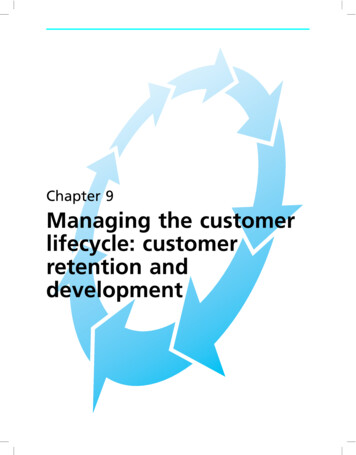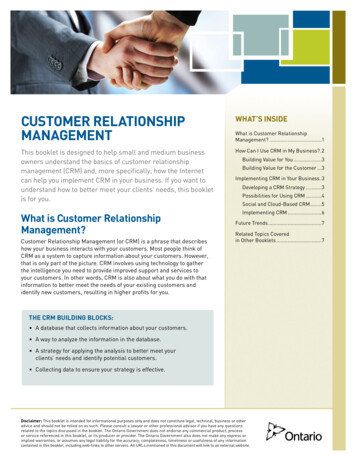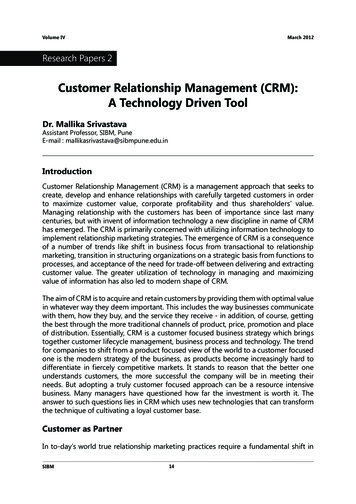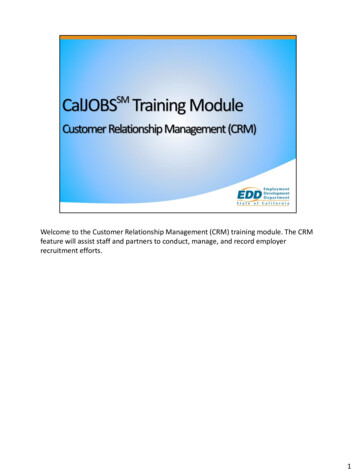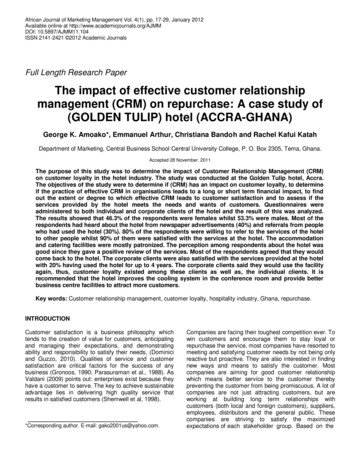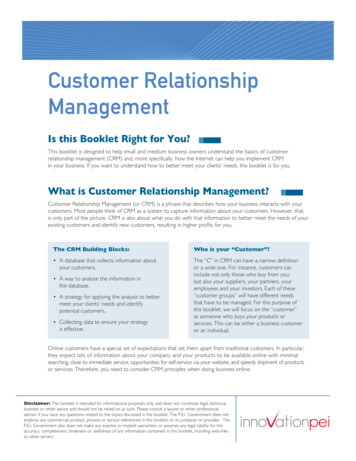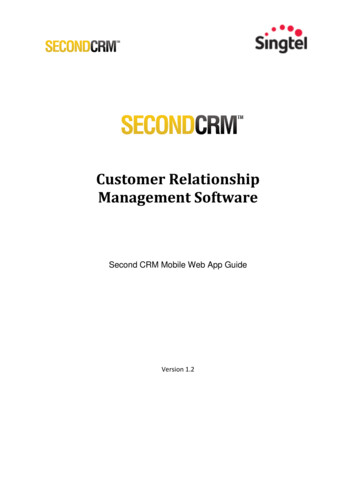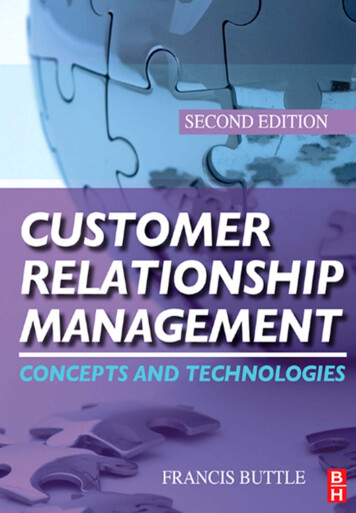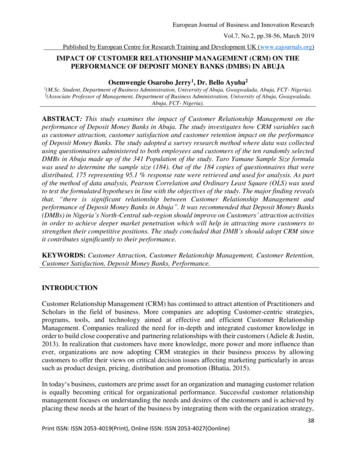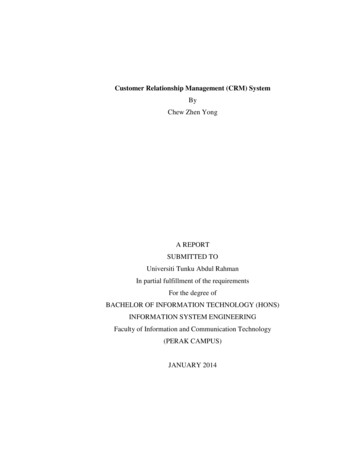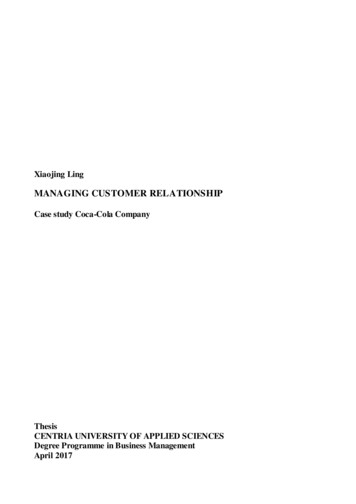
Transcription
Xiaojing LingMANAGING CUSTOMER RELATIONSHIPCase study Coca-Cola CompanyThesisCENTRIA UNIVERSITY OF APPLIED SCIENCESDegree Programme in Business ManagementApril 2017
ABSTRACTCentria Unive rsity of Applied SciencesKokkola- PietarsaariDateAuthorApril 2017Xiaojing LingDegree programmeDegree programme in Business ManagementName of thesisMANAGING CUSTOMER RELATIONSHIPCase study Coca-Cola CompanyInstructorBirgitta NiemiPages43SupervisorBirgitta NiemiThe Coca-Cola Company is an American multinational beverage corporation, a manufacturer,retailer and marketer of non-alcoholic beverage concentrates and syrups with its headquarter inAtlanta, Georgia. This thesis is aimed to affirm the superiority of the Coca-Cola Company and to findout its shortcomings in managing customer relationships based on studying the customerrelationship management strategy for Coca-Cola Company and discussing the comparison betweenCoca-Cola and Pepsi Cola, then put forward the corresponding strategies to solve the problems.The topic is mainly divided into two parts. In the theoretical part, the definition、developmentprocess and main contents of customer relationship management are stated. In the empirical part, theauthor studied the customer relationship management strategy research of Coca-Cola in depth, bycontrast with Pepsi Cola, find out the insufficiency and its reason of the Coca-Cola Co in thecustomer relationship management, then put forward the improvement strategy of the customerrelationship management of Coca-Cola Company.As a result of the thesis, a more effective relationship management strategy for Coca-Cola wasworked out to achieve a win-win between Coca-Cola and customers, meanwhile help Coca-Cola Coto adhere to the customer as the center, cultivate loyal customers and provide the best qualityservice. In addition, the thesis also emphasized the importance of strengthening customerrelationship management.Key w ordsCoca-Cola, customer relationship management, strategy, Pepsi Cola, comparison
ABSTRACTCONTENTS1 INTRODUCTION. 12 CUSTOMER RELATIONSHIP MANAGEMENT . 22.1 Creating value for customers . 32.2 Custome r retention and development . 42.3 Models of CRM. 52.4 The connotation of CRM . 73 CASE COMPANY: PRESENTATION OF COCA-COLA CO. 93.1 Company overvie w . 93.2 Marketing analysis . 103.2.1 The SWOT analysis of Coca-Cola Co. . 113.2.2 The Porter’s five forces analysis of Coca-Cola Co. . 123.2.3 The PESTEL of Coca-Cola Co. . 153.3 Competitor: Pepsi Co. . 184 COCA-COLA CUSTOMER RELATIONSHIP MANAGEMENT STRATEGY ANALYSIS . 214.1 Existing strategies of Coca-Cola Company. 214.2 Comparison between Coca-Cola and Pepsi-Cola . 254.2.1 Custome r relationship maintenance strategies. 254.2.2 CRM guiding ideology . 264.3 Proble ms and reasons . 275 IMPROVEMENT STRATEGIES FOR COCA-COLA . 295.1 Custome r acquisition strategies . 295.1.1 Sales promotion . 295.1.2 Adve rtising . 305.1.3 Merchandising . 315.2 Custome r retention strategies . 315.2.1 Creating custome r delight . 325.2.2 Adding customer-perceived value. 335.2.3 Doing customer research . 345.2.4 Custome r development . 366 CONCLUSION . 38REFERENCES. 39
GRAPHSGRAPH 1. Coca-Cola spending on supplier diversity program . 14GRAPH 2. Beverage consumption in the US . 17GRAPH 3. Leading Global Soft Drink Brands. 21FIGURESFIGURE 1. The QCi customer management model . 6FIGURE 2. The CRM value chain. 7FIGURE 3. Top 20 most valuable global brands 2015. 10FIGURE 4. Porter’s Five Forces Model . 12FIGURE 5. The PESTEL Model . 16FIGURE 6. Customer delight through product quality. 32PICTURESPICTURE 1. The map of Coca-Cola’s location. 22PICTURE 2. My coke rewards website (home page) . 34PICTURE 3. My coke rewards website (registration page) . 34TABLESTABLE 1. SWOT analysis of Coca-Cola Co. . 11TABLE 2. PORTER’s five forces of Coca-Cola Co. . 12TABLE 3. Coca Cola vs. Pepsi Co main indicators. . 19TABLE 4. List of Available flavors of Coca-Cola . 24TABLE 5. Comparison of CRM between Coca-Cola and Pepsi-Cola . 28
11 INTRODUCTIONWith the progress of society and development of science and technology, change rapidly, especiallythe development of information technology has gone beyond our imagination. The development ofinformation technology has also promoted the great progress of customer relationship management(CRM). Customer relationship management has been playing an increasingly important role in theprocess of economic development. Nowadays, many companies pay more and more attention tocustomer relationship management. The fundamenta l reason for companies wanting to buildrelationships with customers is economic. Companies generate better results when they manage theircustomer base in order to identify, acquire, satisfy and retain profitable customers. These are keyobjectives of many customer relationship management strategies (Buttle 2009, 31.) If the company'smarketing is grain, then the customer management is a granary. If grain is not managed, sorted,replaced, it will become worthless waste even if it was put in the granary.Coca-Cola Company is the world's largest beverage company, refreshing consumers with more than500 sparkling and still brands and more than 3,800 beverage choices. More than 1.9 billion servings ofour beverages are enjoyed by consumers in more than 200 countries each day. (www.cocacolacompany.com) How could Coca-Cola Company manage a large number of customer relationships,this is what this thesis wants to study.This thesis is aimed to affirm superiority of Coca-Cola Company and to find out its shortcomings inmanaging customer relationships based on studying the customer relationship management strategy forCoca-Cola Company and discussing the comparison between Coca-Cola and Pepsi Cola, and then putforward the corresponding strategies to solve the problems.
22 CUSTOMER RELATIONSHIP MANAGEMENTIn the era of industrial economy, the rapid development of productive forces has changed the situationof insufficient production capacity and shortage of goods in the whole society. In this case, thecustomer's space of choice significantly increased, customer demand began to show personalizedfeatures, market competition has also become very cruel. In order to achieve market sales, productshave to meet customers’ needs. The pattern of the market is changing from seller's market to buyer'smarket, and the management idea of the enterprise is gradually shifting from "customer-centric" to"customer centered". With the rise of network, the world economy come into the era of e-commerce,the development of information technology makes the idea of customer relationship managementsolidified in the form of flow, and contributed to the birth of customer relationship managementsystem.Customer Relationship Management (referred to as CRM) originated in the United States. At thebeginning of 1980, the concept of "contact management" wa s put forward by American, which was acollection of all the information that customers have to contact with the company. In 1985, BarbaraBender Jackson proposed the concept of relationship marketing, which made people upgrade to a newlevel on the theory of marketing research. In 1990, it has developed customer service that includestelephone service centers and supports data analysis. In order to meet the needs of the increasinglycompetitive market, many American companies began to develop the sales force automation system(SFA), and then focused on the development of customer service system (CSS). After 1996, some UScompanies combined SFA and CSS together, on this basis, integrated computer telephony integrationtechnology, forming CRM prototype which have a set of sales, services in one and includes the callcenter. (Liu 2004.)There is no strict definition of CRM, which has different meanings depending on whom youtalk with. It is the marketing tool to retain customers’ loyalty. It is a value, an attitude that you takeinto your business and with the relations of the customers. Therefore the definitions of CRM vary.(Roberts-Phelps 2001, 2-3.) On the definition of CRM, different research institutions, companies andindividuals have different statements. The most cited is the definition given by Gartner Group andIBM. The Gartner Group is the first one to introduce the CRM concept, which says "CRM is anenterprise-wide business strategy designed to increase revenue, profitability and customer
3satisfaction." Gartner emphasizes that CRM is a business strategy rather than a system that coversthe entire enterprise rather than a department whose strategic goal is to increase profitability, salesrevenue, and improve customer satisfaction. (Ronald 2014.) IBM's definition of customer relationship management inc ludes two aspects: at first, the businessobjective of the enterprise, that is, through a series of technical means to understand the currentneeds of customers and the requirements of potential customers; secondly, enterprises have toachieve completeness and consistency of a customer's information by integrating all aspects ofinformation. IBM believes that customer relationship management is the entire business processthat includes company identifying, picking, acquiring, developing, and maintaining customers.(Ronald 2014.)CRM can be divided into different types: strategic CRM, operational CRM, analytical CRM andcollaborative CRM. Some of the differences of opinion can be explained by considering that a numberof different types of CRM have been identified. Strategic CRM is a core customer-centric businessstrategy that aims at winning and keeping profitable customers. Operational CRM focuses on theautomation of customer-facing processes such as selling, m
managing customer relationships based on studying the customer relationship management strategy for Coca-Cola Company and discussing the comparison between Coca-Cola and Pepsi Cola, and then put forward the corresponding strategies to solve the problems. 2 2 CUSTOMER RELATIONSHIP MANAGEMENT In the era of industrial economy, the rapid development of
